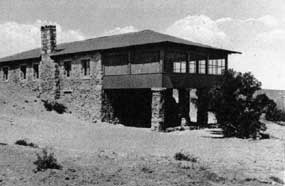 |
 | |
  | |
|
|
|
|
Petrified Forest National Park
People
|
|
|
|
|
| |
 |
 |
| NPS/Marge Post | | Petroglyphs may tell stories, mark events, be prayers, or simply represent symbols important to the ancient culture. |
 |
The Petrified Forest was discovered thousands of years ago by American Indians and was inhabited by groups of them for varying lengths of time. More than 650 American Indian sites have been found in the park, from one-room shelters to a 100-room pueblo near the Puerco River.
When the Spanish began their explorations of the Southwest in 1540, they did not find permanent residents within the Petrified Forest. However, roving bands of Zuni, Hopi, and Navajo people did roam through the area. Ruins of a small group of Navajo hogans also shows that some of the Navajo may at one time have lived in what is now the park.
|
 |
| Camels were brought into the Painted Desert by the US Army in 1857. |
 |
While seeking a route for the first transcontinental railroad, the 1853 Whipple Expedition discovered: "Quite a forest of petrified trees...They are converted into beautiful specimens of variegated jasper...Fragments are strewn over the surface for miles." - Lt. Amiel Whipple. It was Whipple that named Lithodendron ("stone tree") Wash within the Painted Desert.
You may not think of camels when envisioning the Painted Desert, but in 1857 camels were brought into the area as part of a bold experiment. Army Lt. Edward Beale plotted a route for a wagon road that passed through the Painted Desert. Camels were brought in as an experiment in desert travel. Even though they could go for long periods without water, their sand-adapted hooves were no match for the rocks and bentonitic clays of the Painted Desert.
|
 |
| NPS | | Herbert Lore's Painted Desert Inn, also known as the Stone Tree House. |
 |
Not many years after Petrified Forest National Monument was created in 1906, Herbert Lore, an area resident, began to build an inn and restaurant overlooking the Painted Desert. The Painted Desert Inn, or "Stone Tree House," served visitors from 1924-1936. But after a park expansion included the area of Painted Desert completely surrounding the inn, Lore sold his property to the park. Bringing in the Civilian Conservation Corps to provide the labor force, National Park Service architect Lyle Bennett transformed the inn into the unique Pueblo Revival style building still seen today.
Traveling on Route 66, visitors first viewed the Painted Desert, often making a stop at the Painted Desert Inn. Run by the Fred Harvey Company from 1947-1963, the good food, famous Harvey Girl service, and local handicraft items were as much of an attraction as the petrified wood and scenic views. The Fred Harvey Company brought in their architect, Mary Colter, to add new life to the inn. She enhanced Bennett's design elements with bright paint, large picture windows, and indoor wall murals she procured from Hopi artist Fred Kabotie.
|
|
|
|

Civilian Conservation Corps
During the late 1930s, this organization of young men completed many work projects.
more... | | 
Harvey Girls
The Fred Harvey Company civilized the west when the Harvey Girls came along!
more... | | 
Hopi Heritage at the Inn
Artist Fred Kabotie painted six murals on walls inside the inn.
more... | |
|
|
|
|
|
|
|
 |
|
Did You Know?
Petrified wood at Petrified Forest National Park is almost solid quartz, weighing in at 168 pounds per cubic foot. It's so hard, you can only cut it with a diamond tipped saw!
more...
|
|
|
|
Last Updated: September 20, 2007 at 19:54 EST |






